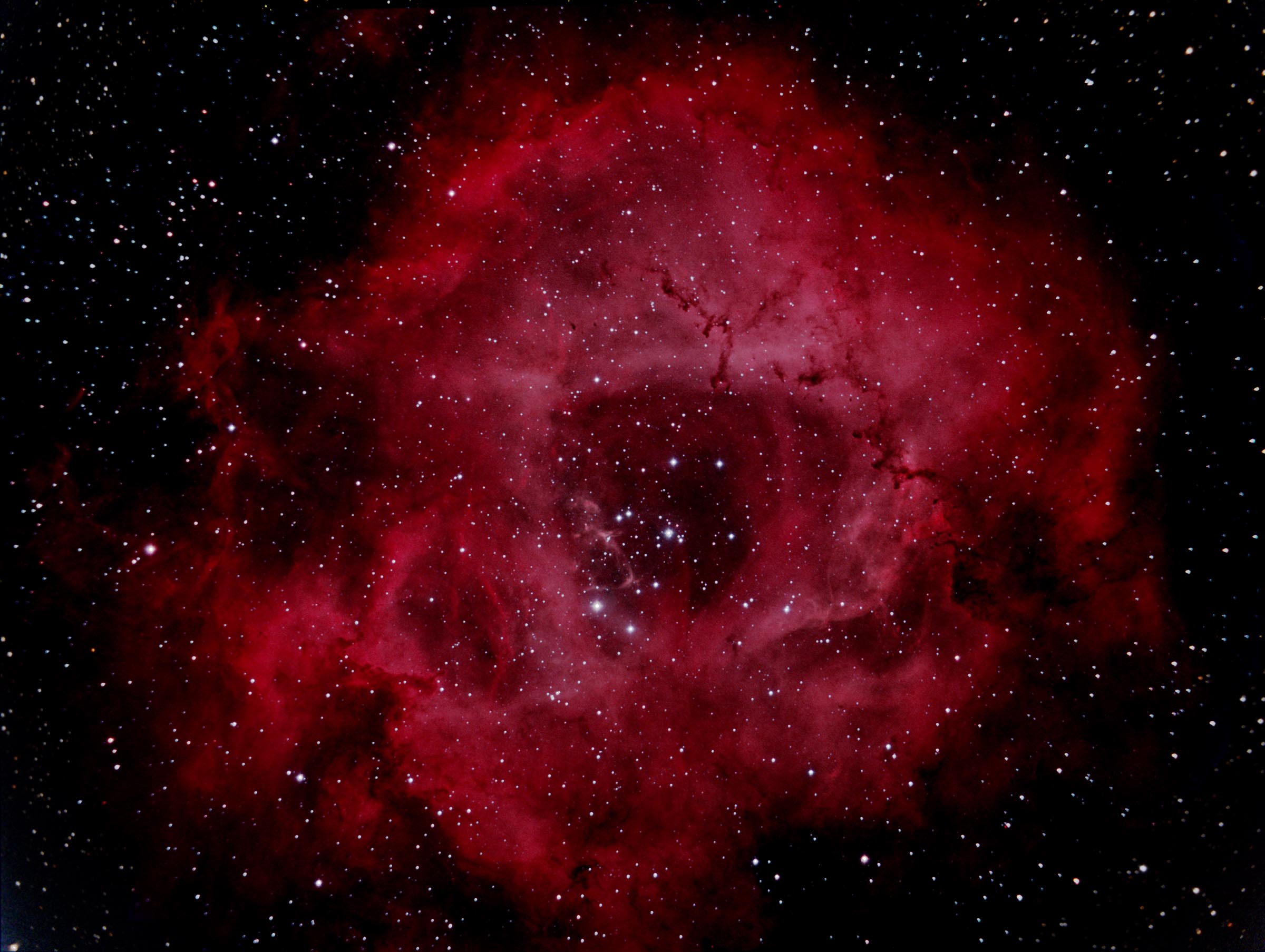
 | SOCO Blog |
01 April 2015
ROSETTE NEBULA
During the weeks since my last entry, I have been furiously working to perfect an image processing procedure that I feel comes close to producing images of astronomical objects that show their "true color". By "tue color", I mean the color they would appear if your eyes were sensitive enough to adequately respond to the weak light coming from the viewed object. As you probably know, there are two sets of light-sensitive receptor cells in your eyes. The rods are sensitive to low levels of light and allow us to see in low-light conditions, like at night. But rods play little role in color vision. Three sets of cone cells, each having a different peak spectral sensitivity (red, green and blue, more or less), provide us with color vision. But they are ineffective at low levels of light. So, in low-light conditions, our vision is essentially monochromatic and we can't perceive colors. So, when we look at an astronomical target like an emission nebula, which we know should be blazing red and pink (due to the spectral emissions of the ionized hydrogen atoms that make it up), all we see is a softly glowing gray-ish fuzzy patch. The objective of my image processing procedure is to present astronomical objects in the colors that we would see if our cone cells could respond to the low light levels.
The procedure, which I call "Exoatmospheric G2V Correction", is described in the Image Processing section of the SOCO website. It is related to other processing procedures that use sun-like (spectral class G2V) stars to calibrate the color balance of color composite (RGB) images. However, a key feature of exoatmospheric G2V correction is that the normalization of the red, green and blue fluxes of light (which is characteristic of color correction procedures based on G2V stars) occurs outside the atmosphere. The resulting effect on the color balance of astronomical objects is then translated downward through the atmosphere to the observer on the ground based on atmospheric transmissivity. This is an entirely objective image processing procedure, with no subjective fiddling with the color balance to "make it look right". I believe that the resulting images show a close approximation to the colors that the astronomical objects would really exhibit if our eyes were sufficiently sensitive.
To develop the procedure, I had to make a lot of photometric measurements on G2V stars currently in the sky at night. In addition, I collected imagery of astronomical objects to use in evaluating the procedure. One of these objects was NGC 2244, the beautiful Rosette Nebula in the constellation of Monoceros. This nebula is quite bright, and it and its accompanying open cluster can easily be seen through binoculars lying just off the left shoulder of Orion. The Rosette is an emission nebula like the Great Nebula in Orion (M42), so its light will be dominated by ionized hydrogen emissions in the red (Hα, 656.3 nm) and, to a lesser degree, blue (Hβ, 486.1 nm) wavelengths. Thus, the nebula should have an overall reddish to pinkish color.
The resulting image of the Rosette Nebula produced using exoatmospheric G2V correction is presented below. The bright reds along the outer edges of the nebula result from the strong Hα emissions. The nebula is more pinkish near the center. This could result from light from the young, hot, blue-white cluster stars at the heart of the nebula reflecting off dust in the nebula around them— the combination of red nebula emissions and blue reflected starlight puts a pinkish hue on this part of the nebula.

The Rosette Nebula (NGC 2244) in Monoceros
To produce this image, ten 90-second monochrome images were shot through each of red, green and blue filters (30 images in all). These exposures were fairly short but, as I said, this is a relatively bright nebula. Dark frame images were used to subtract the sensor noise from the imagery, and previously collected flat frame images were applied to correct for variations in brightness across the imagery due to characteristics of the optical system. Each image was corrected for atmospheric transmissivity based on the zenith angle of the observation. Weight factors were then applied to each image to correct the color balance according to the exoatospheric G2V correction procedure. I'm hoping to place a revised step-by-step image processing procedure on the SOCO website soon that covers all these processing activities. All image processing was performed using AIP4WinV2 and Maxim DL.
The Rosette Nebula is a very popular target for astro-imagers. It's interesting to google it and check out the many images of it on the web. In looking at these images, you're likely to find many different color renditions of it, from bright red to orange to soft pink (and I'm not including the Hubble-style false-color versions, which are not intended to be "true color"). Everyone has their own way they like to see astronomical objects— some more realistic and others more artistic.
 Return to SOCO Blog Page
Return to SOCO Blog Page
 Return to SOCO Main Page
Return to SOCO Main Page
Questions or comments? Email SOCO@cat-star.org